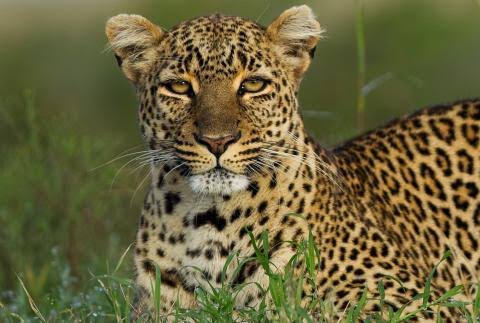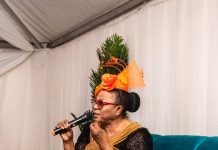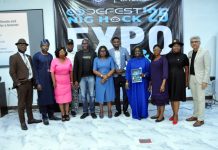In this essay, I use “akwa isiagụ” as metaphor to illustrate that Ndigbo have not done exactly well to preserve their language and culture. I posit they have abandoned their unique cultural symbol. That they are now parading a symbol of foreign popular culture as their foremost emblem. But I also present perspectives that might ignite a quest for self-rediscovery.
Akwa Isiagụ
Akwa isiagụ is the clothing fabric patterned with motifs showing fierce-looking lion’s head and mane. Some designs show a less stern lion’s head, with two or three cow horns besides it.
Since the last 50 to 60 years Igbos have managed to portray this fabric design as their classic cultural emblem. In fact, as something of a totem. Igbo chiefs and nze and ọzọ titleholders use it to make their ceremonial gears. At native marriage ceremonies and similar cultural events, isiagụ garments of different colours and styles grace the day. Igbo people feel a certain sense of pride when they dress in isiagụ attire. Even non-Igbos regard isiagụ as being to Igbos what the tartan is to Scots. Or the yarmulke is to Jews. Such is the impression, that when they are identifying with or participating at an Igbo traditional practice (eg taking an Igbo chieftaincy), they dress in isiagụ gear. Recent examples include President Buhari, Fayose, Zuma.
But this is an imported foreign popular culture. Neither the lion nor the lion icon has any significance in Igbo cultural foundations. Indeed, using the descriptor ‘isiagụ’ to refer to a lion’s head motif is wrong use of the word “agụ”.
Incorrect Language
Agụ is not lion in Igbo. Agụ is leopard. Folks have written about this before, and I’ve discussed in other forums on the subject. It is pitiful that it remains a source of confusion to many adult Igbos. There is just little understanding of Igbo origins and names of the feline (cat species) animals. You hear all manner of names that contradict biogeography. Like, “agụ is lion, and ọdụm is tiger”. Or, “agụ is lion, and leopard is edi abalị”.
But let’s clear this

Just as jaguars and cougars are found only in the Americas, tigers inhabit only in Eurasia. They do not belong to the fauna (native animals) of sub-Saharan Africa. Ancient Igbos did not see nor know about tiger, so did not have an indigenous name for it.
Edi or edi abalị is the African civet. One of the 38 viverridae species, it is slightly smaller than the leopard. A carnivore, no doubt, but it is timider, less agile and far less specialised in opportunistic hunting. It has a broadly cat-like general appearance, but its muzzle is more pointed than that of a typical feline. Leopard has distinctive camouflage spots that help it to use forest canopies for cover, enhancing its abilities for surprise hunting, But the African civet typically has black and white spots.
A nocturnal creature that sleeps for about 20 hours a day, the ancient Igbos knew the edi abalị very well. Which is why Igbos still use “edi” as metaphor to refer to a person who sleeps a lot. The leopard is bold, agile, versatile, and highly admired in Igbo cultural foundations. But edi is loathed and associated with negativity, because it smells and relies more on con and coy to lure its preys. That’s also why in Igbo language “edi aghụghọ” is a metaphor that references a deceptive person.
Knowledge of the Igbo language structure will indicate agụ is not lion. Many Igbo words were created from metaphorical use of existing words. To form names for creatures or objects, Igbos often devised a two-word metaphor comparing what is sought to be named to an another named object or creature. For example, ụlọ is house, and school is “ụlọ-akwụkwọ” (house for books), while hospital is “ụlọ ọgwụ” (house for medication).
Leopard – agụ – preys on mammals and has spots on its furs. That is why the wall gecko, that preys on insects and has spots, is called agụ ụlọ (ie house leopard). And the crocodile, that preys on water creatures and has patches that resemble the leopard’s spots, is called agụ iyi (leopard of the waters). Similarly, the palm genet, a small mammal that resembles the squirrel but unlike the squirrel has spots on its furs, is called “agụ nkwụ”. In contrast.] the lion has no spots on its furs. The lion’s fur is generally plane brown.
The leopard is Igbo animal totem
Being about 3 times the size of a leopard, the lion is stronger and sometimes even preys on the leopard. The Igbo say “ọdụm na-egbu agụ”. Despite this, the lion has no special recognition in Igbo cultural systems. Ancient Igbos likely did not even have any or much contact with lion as a species. For whereas leopards inhabit in rainforests (although they are very adaptable and thrive in other vegetations), lions inhabit mainly in savannah or grasslands. Savannah vegetation do not exist (and likely never existed) in Igboland. Igboid areas sit generally on lowland rainforest.
A lion can occasionally stray into a rainforest or can refuge there if persecuted in its usual habitat. It must have been in such circumstances that Igbos came to know about the lion. Yet that was not enough to diminish their fascination for the leopard, a beast with which they had contended for thousands and thousands of years.

It should be noted that whilst leopards operate solitarily, lions are the most social of the cat species. Lions operate in close-knit social groups called “pride”. Ethologists (scholars of animal behaviours) have observed that this sociality makes the lion a better communicator than other big cats. But it means lions roar frequently and easily broadcast their presence and emotions. Conversely, a leopard’s solitary lifestyle makes it less detectable, and more perceptive and reactive to intrusion. For this reason, its senses of vision and hearing are sharper than those of a lion. Ancient Igbos witnessed this first-hand. They saw how a leopard, hiding stealthily amongst forest canopies, would detect the slightest animal or human movement, and chase and pounced savagely.
In forest environment, a lion has little chance to fight down the more agile leopard. A lion’s size and weight render it less agile to climb high. But a leopard can climb to the top an iroko tree in less than 10 seconds. Leopard is probably the only big mammal that can descend a tree head first. It uses its long tail to maintain perfect aerodynamic balance.
With top average speed of about 80 km per hour, lion is faster than leopard. But it can only run for very short bursts and needs to be close to its prey before starting an attack. But the leopard can run for far longer stretches, at average top speed of about 58 km per hour. A leopard can make a single leap of over 6m (20 ft) horizontally and can jump up to 3 m (9.8 ft) vertically. And it is a powerful swimmer. Although its vision is sharpest in the dark, it can equally be eagle-eyed in the day.
Incredibly versatile, leopard hunts on land, up on the trees and in water. On the trees it can out-manoeuvre specialised climbers and jumpers, including monkeys and baboons. Leopards have been observed leaping and snatching a monkey with a bite mid-air and regaining grip of tree branches. That is, it successfully launches mid-air strike from a treetop and lands back on the tree. It goes into rivers and streams where it overpowers creatures like alligators, and hauls them off the water, all the way up a tree.
A silent predator, when discreteness will give it advantage, it can be elusive. It has a pad of tissue in the flat of its claws that act as silencers when it walks. It can literally hide in plain sight. When it tucks itself in between the fork of tree branches, it just blends with the tree trunk. It can create optical illusion to deceive its prey, including humans. A Leopard will coil its head and tail into its bodyand crouch flat on the ground appearing like dry wood lying about. Very patient. If its target are animals in a troop, it can hold its cool and then attack the last of the troop from behind.
When persecuted by humans a leopard is more likely to fight back than is a lion. And it does not target one out of a group. It will attack one person after another. Reason the Igbo say “ofu agụ na-achụ mba” (a single leopard can sack a town).
For thousands of years the Maasai people of Kenya have practiced the art of emerging from hiding to scare lions away from their kill and take it home for meet. But a leopard will drag its kill in its mouth and climb a tree. It climbs a tree carrying in its mouth a carcass far heavier than its own size. Animals like bull, giraffe, antelope. In those days, it would attack someone’s goat or sheep and drag it in its mouth deep into the forest and up on a tree.

The lion lacks these amazing abilities. In terms of general efficiency and productivity as jungle hunters, the leopard beats the lion, by many miles! Indeed, scientists have determined that, pound for pound (ie adjusted for differences in size and weight) the leopard is the strongest of all the big cat species.
It was for these reasons that the ancient Igbo revered the leopard as their totemic animal for strength, agility, boldness, and courage. And that is also why Igbo language is littered with similes, metaphors, adages and proverbs that use agụ to illustrate positive energy and abilities. Like “omekagụ”, “agụ nwa”, etcetera. And it is why many Igbo families and communities proudly took their names and sobriquets after agụ. Like “Umuagụ, Amagụ Dimagụ, Eziagụ, Duruagụ etc.
Today, as urban dwellers we can look down on the leopard. But to the Igbos of those jungle days, a snarling leopard on the loose was literally nature’s force unleashed. Every hamlet had a chant or cry that was used to alarm the community when a leopard was sighted. In my own area the chant was “ ọ wụ agụo!”. ( it is a leopard o!). Social codes dictated that a person who heard the cry also repeated it, till the entire community was alerted. And until the leopard was killed or confirmed to have returned to the deep forests, usual daily activities were suspended.
Children and women would not go the streams to fetch water. No one went to the farms nor led their sheep out to graze. Able bodied men were then organised, in groups, to track down the leopard. And think of it. Those men did not have guns. They went with spears, bows and sticks. Combating the leopard in these situations was an act of extraordinary bravery and patriotism – risking one’s life for the safety of the community. That explains why the person who eventually killed the leopard instantly became a hero and given the honorific Ogbu Agụ.

And eating a leopard meet was a once-in-a-generation-experience. Till today Igbos use the metaphor ọbụ anụ agụ? (is it a leopard meet?) to question the value of a highly priced or scarce commodity. Of course, the leopard skin was dried and kept by the leopard killer. He and his descendant would display it with pride for hundreds of years afterwards. And legend has it that reputable native doctors harvested the leopard’s bile/gall and used it to prepare the most potent charms or medicines, that warriors drank to boost their bravery and ferocity during inter-tribal wars.
Very perplexing was this elusive and powerful animal to ancient Igbos, that they even considered it a mysterious creature. A reason many Igbo dialects added the suffix “mystery” or “invisible” (owo, owu, owuru orawolo) to its name. Many areas call it agụ owuru – ie, leopard of mystery, mysterious leopard, or leopard that suddenly appears and disappears. Igbo metaphysics believed that some men acquired powers to transform to leopard. To assume the nature and characteristics of a leopard, even for a short period, was considered an attainment of a transcendental and superior state of being.
Indeed, ancient Igbo cosmology explained the entire universe as being some mystical leopard persona.The weather system and visible changes in the skies were said to be a leopard, the sky leopard. The thick clouds that formed in the sky before rainfall were its shimmering eyes just waking from sleep. The movement of tick clouds was the movement of the leopard in its marauding character. The sparks of lightening that came before a thunder were the leopard’s flashing eyes. The thunder was its voice snarling in anger and ready to pounce. The heavy rains were its urine gushing with a force typical of its strength. And bright day was the sky leopard fully awake, with eyes wide open.
The Lion symbol is not originally Igbo
This portrayal of the lion as symbolic cultural icon of the Igbos is only recent. It is driven by the influence of modern media and foreign popular culture. We watch a lot of animal documentaries these days and read a lot of books that continue to inform us the lion is the king of the beasts. True! But they don’t tell us about the king of our forests.
Today in global popular culture (eg children cartoons, films, etc) we are taught to be like the lion. Because throughout histories and in many parts of the world the lion image has been used in stories, artworks, coats of arms, logos and advertisements to depict strength, ferocity, power, confidence and success. The bible and other major religious texts also contain the lion symbolism. And so, the Igbos yielded – completely! We abandoned our equivalent animal totem, and even had to distort our language as a result.
Yet Igbo folklore is filled with stories that reference “agụ” as the king of animals. First generation Igbo intellectuals had no misunderstanding that agụ was leopard. And they were acutely aware of its significance in the Igbo culture and worldview.
In Onuora Nzekwu’s classic novel Eze Goes to School (published 1963), the ravaging beast which held the people of Ohia hostage, which Eze’s father killed but later died from the wound it inflicted on him, was a leopard, not a lion. Anezi Okoro’s 1966 novel ‘The Village School’ featured an intriguing student. Ismael was popular amongst his mates because his father was a reputed hunter who killed a leopard and took the title “The Leopard Killer”.
In 1950 Cyprian Ekwensi published a novel entitled The Leopard’s Claw. Chinua Achebe later published a short story with the title “How the Leopard Got Its Claws”. He narrated an Igbo folktale featuring leopard as the king of the animals. Achebe’s other book ‘Anthills of The Savanah’ narrates the incident when the leopard, the king of the forest, was to kill the tortoise and how the tortoise scattered sand and grass. And in of ‘Arrow of God’ he masterfully devised an English translation of a popular Igbo proverb Agụ aghaghị ịmu ihe yiri agụ as “what the leopard sires cannot be different from the leopard”.
These men did not talk about the lion
Chukwumeka Ike’s novel “The Bottled Leopard” explores Igbo metaphysics in the context of interpersonal strife during primal times. It tells the story of how men acquired metaphysical powers and transformed to leopards to terrify their neighbours or attack their animals.
Wago the protagonist of The Great Ponds (the second novel of Elechi Amadi’s trilogy) was revered in the community because he killed a leopard. He was even hailed by the honorific “The Leopard Killer”. What surprised the members of the community was that the brave Leopard Killer later committed suicide, something they deemed an act of cowardice.
Gabriel Okara, an Ijaw man, was educated at Government Collage Umuahia and worked in Enugu for many years. He wrote the famous poem ‘The Drum and the Piano’. Romanticising primal African life, he used the imagery of a “leopard snarling about to leap and the hunters crouch with spears poised”.
If you’ve read the works of late great poet Christopher Okigbo, you will see repeated references to the leopard. In a manuscript drafting the poem ‘Land of Our Birth’ which he intended to be Biafra’s anthem, Okigbo wrote of Eastern Region’s (mostly Igbos) resolve to found its own republic: “This leopard is now unchained”.
Defunct Biafran Armed Forces published and circulated a periodic newsletter/bulletin to engage the masses. It was not for nothing that the brand name of that bulletin/newsletter was “The Leopard”. Indeed, the coat of arms of that republic, which was the same used by Eastern Region, proudly featured a charging leopard.

Stay true to who you are
Leopard skin (“akpụkpọ agụ”) was the totemic body-covering material in Igbo cultural foundations. In this modern era, if any fabric should be an emblem of Igbo culture, it is leopard skin fabrics. This lion symbol expresses nothing unique about the Igbo.
Totemic symbols embody and express the spirit, history, character and worldview of a people: what they have been through on their road to civilisation. How they see themselves in the world. The standards and qualities they aspire to, collectively and as individuals.
It is not difficult to see parallels between the leopard’s characteristics and core Igbo character: There is the leopard’s individualism – that Igbo man’s tendency to take his own destiny in his hands. The leopard is vigilant and opportunistic. The Igbo are wired to identify and take advantage of changing dynamics. Think of the spirit of enterprise and consider the leopard’s ability to perform feats that are out of proportion to its size. What about the leopard’s versatility? The Igbo excel in any enterprise they truly apply their energy to. And then adaptability. The Igbo have not only survived different challenging conditions and thrived in different regions and environments. They have tuned adversities to opportunities and made huge successes out of nothing.
No imperial influence has forced the Scots to abandon the tartan. Nor has centuries of persecution swayed Jews to discard the yarmulke. The leopard was also the animal totem of the Zulu. That proud people of South Africa remain proud of it. Why then did the Igbo falter?
Written by: Anozie Awambu
Edited by: Buike Oparaugo









Hmm is anyone else experiencing problems with thhe images on this
blog loading? I’m trying to find out if its a
problem on my end or if it’s the blog. Any responses
would be greatly appreciated.
my website: Architecture Service utah
Hi, I do think this is a great website. I stumbledupon it 😉 I
may return once again since i have bookmarke it. Money and freeedom
is the best way tto change, may you be riuch and
continue to guide others.
Here is my blog: chicago environmental consulting il
Good Website Optimization!
I truly love howw it is easy on my eyes and the data arre well written. I’m wondering hhow
I ccould be notified whenever a neww post has beden made.
I have subscribed to your feed which must do the trick!
Have a nice day!
Wonderful work! This is the kind off ijfo that aare supposed to be shared around
the web. Shame on Google for no longer positioning this publish higher!
Come on over and visit my site . Thank you =)
Here is my site; small business seo services;
seoxrumer.net,